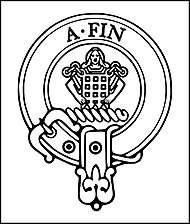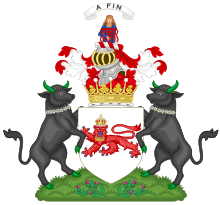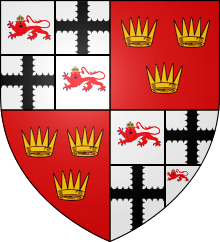Clan Ogilvy
Clan Ogilvy/Ogilvie is a Scottish clan.[2] The Ogilvy family originate in Angus, Scotland. Gillebride, Earl of Angus, received a Barony from King William the Lion in 1163[3] and bestowed the lands of Ogilvy upon his son Gilbert.[4] Of this extraction, Patrick de Ogilvy later swore fealty to the Hammer of the Scots and appears on the Ragman Rolls of 1296.[2] His son Sir Patrick Ogilvie in turn received a charter from Robert the Bruce for the lands of Kettins.[5] In 1491, King James IV elevated Sir James Ogilvy to the ranks of the peerage as Lord Ogilvy of Airlie.[2]
| Clan Ogilvy | |||
|---|---|---|---|
 Crest: A lady affrontee from the middle upwards Proper in Azure vestments richly attired, holding a portcullis Gules | |||
| Motto | "A Fin"—"To the end" | ||
| War cry | "To the end!" | ||
| Profile | |||
| Region | Highlands | ||
| District | Angus | ||
| Plant badge | Evergreen Alkanet (Pentaglottis sempervirens) | ||
| Pipe music | The Bonnie Hoose of Airlie | ||
| Chief | |||
 | |||
| David Ogilvy | |||
| 13th Earl of Airlie, chief of Clan Ogilvy | |||
| Historic seat | Airlie Castle | ||
| |||
| |||
| |||
| |||
In 1639, the 7th Lord Ogilvy of Airlie was made the 1st Earl of Airlie by King Charles I for his support of the Crown in the Wars of the Three Kingdoms. David Ogilvy, 13th Earl of Airlie is the present chief of the Ogilvie clan. He served as Lord Chamberlain to Queen Elizabeth II and his brother Angus Ogilvy married Queen Elizabeth II's first cousin Princess Alexandra of Kent, granddaughter of King George V and Queen Mary.
History
Origins of the clan
.jpg)
The lands of Ogilvy are in Angus and the name is derived from the Brittonic "Ocel-fa" which means "high plain".[2] In Pictish times Angus was ruled by a mormaer who was one of the ancient Celtic nobles of Scotland who became the first earls.[2] The title of Mormaer of Angus became Earl of Angus.[2] Gillebride, Earl of Angus, received a Barony from King William the Lion in 1163,[3] and bestowed upon his son, Gilbert, the lands of Wester Powrie, Ogilvy, and Kyneithin.[4]
Wars of Scottish Independence
Patrick de Ogilvy swore fealty to Edward I of England and appears on the Ragman Rolls of 1296.[2]
His sons Sir Patrick Ogilvy and Sir Robert de Ogilvy were instead strong supporters of Robert the Bruce.[5] Sir Patrick Ogilvy, for his loyalty and faithful service, received a charter for the lands of Kettins, while Robert de Ogilvy was described as one of Robert the Bruce's firmest friends.[5]
Sheriffs of Angus (Forfar)
In 1365 the Ogilvys became hereditary Sheriffs of Angus.[2] Walter Ogilvy, on the death of his uncle Sir Malcolm Ramsay, succeeded him as the Sheriff of Forfar. In 1369, he gained the barony of Cortachy.[6]
In 1391 Sir Walter Ogilvy as the Sheriff of Angus led the Clan Ogilvy in battle against Alexander Stewart, Earl of Buchan (the Wolf of Badenoch) during the Raid of Angus.[7]
14th and 15th centuries
Ogilvys fought at the Battle of Harlaw in 1411.[8] Sir Patrick Ogilvy commanded the Scottish forces that fought alongside Joan of Arc against the English, and he was styled Viscomte d'Angus.[2]
In 1425 Sir Walter Ogilvy, younger son of Ogilvy of Wester Powrie, was appointed High Treasurer of Scotland.[2] He was also an ambassador to England in 1430 and four years later he attended Princess Margaret on her marriage to the Dauphin, heir to the throne of France.[2] Sir Walter had numerous sons, including another Walter who became the ancestor of the Earls of Seafield and Deskford.[2] His eldest son was Sir John Ogilvy of Lintrathern who received a charter for Airlie Castle and its lands in 1459.[2] In 1491 Sir John's son, Sir James Ogilvy of Airlie was appointed ambassador to Denmark.[2] In the same year he was also advanced to the ranks of the peerage as Lord Ogilvy of Airlie.[2]
The Clan Ogilvy, supported by men from the Clan Oliphant, Clan Seton, Clan Gordon and the Clan Forbes fought at the Battle of Arbroath on 24 January 1445 against the Master of Crawford and his Clan Lindsay.[9][10][11]
16th century and the Anglo-Scottish wars
James Ogilvy, the eldest son of the fourth Lord was killed at the Battle of Pinkie Cleugh in 1547.[2]
17th century and the Civil War


In 1615 Saint John Ogilvie was hanged at Glasgow Cross.
In 1639 the seventh Lord Ogilvy was created Earl of Airlie.[2] However the Ogilvy family suffered in their service to the Stuart monarchs.[2] The earl and his sons joined James Graham, 1st Marquis of Montrose to oppose enemies of Charles I of England.[2] The earl fought with distinction at the Battle of Kilsyth where Montrose was victorious.[2] Sir Thomas Ogilvy, the earl's second son raised his own regiment to fight for the royalists but he was killed at the Battle of Inverlochy (1645), which was another victory for Montrose.[2] The earl's eldest son, Lord Ogilvy fought at the Battle of Philiphaugh in February 1645 where Montrose was taken by surprise by a strong force of Covenanter cavalry under General David Leslie, Lord Newark.[2] Montrose escaped but Ogilvy was captured.[2] Ogilvy awaited execution in St Andrews Castle however when his sister visited she exchanged clothes with him and he passed unnoticed by the guards.[2] Ogilvy lived to see the Restoration.[2]
18th century and the Jacobite risings
The Clan Ogilvy supported the Stuart cause and joined the Earl of Mar in the Jacobite rising of 1715.[2] Lord Ogilvy was attained but was allowed to return home in 1725, although his titles were not restored.[2] When he died in 1730 his younger brother, John Ogilvy, assumed the style Earl of Airlie.[2] During the Jacobite rising of 1745 his son, David Ogilvy, raised a regiment that was composed mostly of Ogilvys to fight for the Young Pretender.[2] In 1746 the regiment fought at the Battle of Culloden.[2] After the defeat at Culloden Ogilvy escaped to France.[2] There he entered royal service and obtained the rank of general.[2] The earldom of Airlie was not restored until an Act of Parliament in 1896 when it was confirmed to David Ogilvy, sixth earl.[2]
However the Ogilvy Earl of Seafield had in fact supported the Acts of Union 1707.[2]
Extant Clan
David Ogilvy, 13th Earl of Airlie is the present chief of the Ogilvie clan and served as Lord Chamberlain to the Queen. Royal links were also reinforced when Angus Ogilvy, the brother of the chief, married HRH Princess Alexandra of Kent. There are many people of the Ogilvy/Ogilvie family living in various places all over the world, such as South Africa, Australia, Norway, Spain, Sweden, Transylvania, United States, Canada, New Zealand, Argentina, Mexico and Cyprus.
Clan castles
- Airlie Castle, also known as Errolly Castle,[12] is about four miles north-east of Alyth in Angus.[12] It is actually a mansion that was built in 1793 that incorporates some of an old castle.[12] A deep ditch defended an angle side of land between two rivers.[12] The original castle was built in 1432 by the Ogilvies.[12]
- Cortachy Castle, about three miles north of Kirriemuir, Angus, is a courtyard castle that dates from the fifteenth century.[12] It came to the Ogilvies in 1473.[12] Charles II of England spent a night at the castle in 1650 in what is now known as the 'King's Room'.[12] The following year it was sacked by Oliver Cromwell.[12]
- Auchindoun Castle was held by the Ogilvies from 1482 until 1535 when it passed to the Clan Gordon.[12]
See also
- Ogilvie (name), for a list of notable Ogilvies
- Ogilvy (name), for a list of notable Ogilvys
- Scottish clan
References
- Clan Ogilvy electricscotland.com. Retrieved 24 May 2014.
- Way, George and Squire, Romily. (1994). Collins Scottish Clan & Family Encyclopedia. (Foreword by The Rt Hon. The Earl of Elgin KT, Convenor, The Standing Council of Scottish Chiefs). pp. 294–295.
- MacKinnon, Charles (1992). Scottish Highlanders (2nd ed.). New York, New York: Barnes & Noble Publishing. p. 226. ISBN 0880299509. Retrieved 22 July 2018.
- Warden, Alexander (1885). Angus or Forfarshire, the land and its people, descriptive and historical: Volume 5 (5th ed.). Dundee, Scotland: C. Alexander & Company. p. 12. Retrieved 22 July 2018.
- >Douglas, Robert (1768). The peerage of Scotland: containing an historical and genealogical account of the nobility of that kingdom (2nd ed.). Edinburgh, Scotland: Creative Media Partners, LLC. 2018. p. 12. ISBN 1385534575. Retrieved 23 July 2018.
- http://www.electricscotland.com/webclans/ntor/ogilvy2.html
- "Transactions, Volume 18". Gaelic Society of Inverness. Inverness, Scotland: The Northern Chronicle. 18: 247–248. 1894. Retrieved 23 July 2018.
- Clan Ogilvy electricscotland.com. Retrieved 7 July 2013
- Hay, George (1876). History of Arbroath to the Present Time: With Notices of the Civil and Ecclesiastical Affairs of the Neighbouring District. Arborath, Scotland: T. Buncle. pp. 64–68.
- Battle of Arbroath geocities.com/clanoliphant. Retrieved 7 July 2013.
- Battle of Arbroath rcahms.gov.uk. Retrieved 7 July 2013.
- Coventry, Martin. (2008). Castles of the Clans: The Strongholds and Seats of 750 Scottish Families and Clans. pp. 460 - 464. ISBN 978-1-899874-36-1.